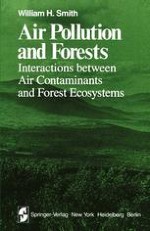1981 | OriginalPaper | Buchkapitel
Forests as Sinks for Air Contaminants: Vegetative Compartment
verfasst von : William H. Smith
Erschienen in: Air Pollution and Forests
Verlag: Springer US
Enthalten in: Professional Book Archive
Aktivieren Sie unsere intelligente Suche, um passende Fachinhalte oder Patente zu finden.
Wählen Sie Textabschnitte aus um mit Künstlicher Intelligenz passenden Patente zu finden. powered by
Markieren Sie Textabschnitte, um KI-gestützt weitere passende Inhalte zu finden. powered by
In addition to the soil compartment, the vegetative compartment of forest ecosystems functions as a sink for atmospheric contaminants. As in the case of soils a complex variety of biological, chemical, and physical processes are involved in the transfer of pollutants from the air to the surfaces of vegetation. For certain contaminants, for example, persistent heavy metal particles, the repository functions of vegetation and soils are intimately linked as a portion of the heavy metals input to the soil are derived from vegetative sources contributing litter to the forest floor. Interest in the ability of plants to remove pollutants from the air has grown considerably in recent years as individuals have become increasingly aware of the amenity functions (Heisler, 1975; Smith, 1970a) of woody plants, particularly in urban and suburban areas. The capability of plants to act as a sink for air contaminants has been addressed by a variety of recent reviews, for example, U.S. Environmental Protection Agency (1976a), Smith and Dochinger (1976), Bennett and Hill (1975), Hanson and Thorne (1972), Hill (1971), Environmental Health Science Center (1975), Keller (1978), and Warren (1973). These papers indicate that the surfaces of vegetation provide a major filtration and reaction surface to the atmosphere and importantly function to transfer pollutants from the atmosphere to the biosphere.
